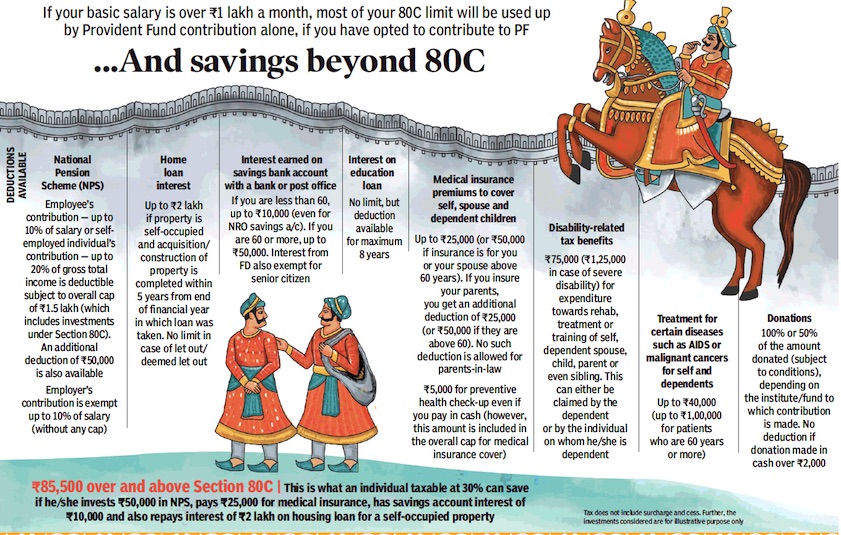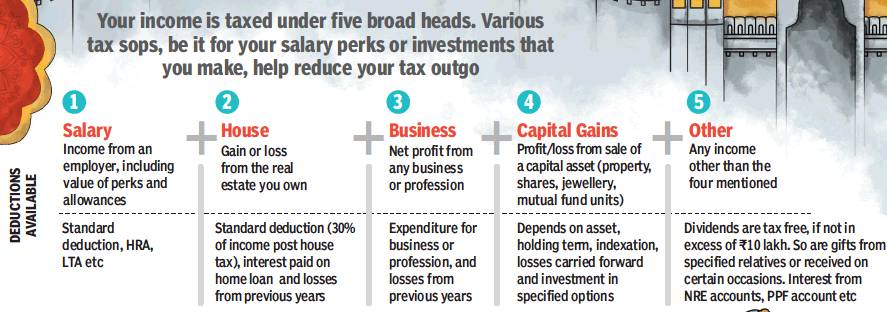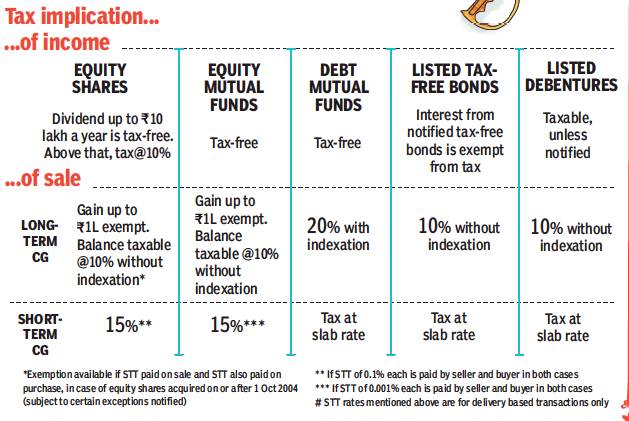Income Tax India: Expert advice, 2018-19
This is a collection of articles archived for the excellence of their content. |
Contents |
How to reduce tax
February 2, 2018: The Times of India
Like scissor-happy film censors, taxmen are looking to snip off your pay cheque. The Times of India–EY Guide looks at the fine print of the Finance Bill and tells you how you can save your salary from the taxman, with as few cuts as possible
10 things individual taxpayers should know
Standard deduction of 40,000 is introduced but tax exemption for transport allowance of 1,600 per month and annual medical expense reimbursement of 15,000 is taken away – resulting in maximum tax savings of 2,081
Health and education cess @ 4% of income tax (including surcharge) replaces existing education cess and higher education cess @ 3%. Highest tax rate for individuals with taxable income of over 1 crore is up from 35.5% to 35.8% (nearly 36%)
Several reliefs for senior citizens:
(a) deduction for interest income from bank deposits, co-operative societies or post office up from 10,000 to 50,000; (b) deduction for health insurance premium and medical expenditure up from 30,000 to 50,000; and (c) deduction for treatment of specified diseases up from 60,000 to 1 lakh
Exemption on long term capital gains on sale of assets restricted to land or building.
Holding period of notified bonds increased to 5 years. This reduces scope of claiming capital gains tax exemption on sale of securities, jewellery, art etc
Withdrawal from National Pension Scheme is exempt from tax up to 40% of total amount payable for salaried individuals. This benefit is now extended to self-employed individuals also No adjustments to sale consideration on transfer of immovable property where variation between stamp duty value and sale consideration is not more than 5% of latter. This will reduce hardship for genuine transactions in real estate
Long-term capital gains (LTCGs) exceeding 1 lakh on sale of listed equity shares and listed equity-oriented mutual funds to be taxed @ 10% without indexation benefit. However, this will not apply to appreciation up to fair market value as on January 31, 2018. STT on such transaction continues to be levied. This will increase tax burden for long-term investors
Dividend distribution tax introduced @ 10% on dividend payouts to unit holders of equity-oriented funds. Cash available for distribution will decline, resulting in lower dividend payouts
If income in I-T return was lower than the figure in Form 26AS, Form 16A or Form 16, it led to issue of a demand notice. Now, for such mismatch you will not a receive a notice; this will reduce litigation. This beneficial amendment is retrospective from FY 2017-18
If you’ve been laid off and receive a compensation, it will now be taxed as ‘Other Income’. Earlier, one would have argued that it is a non-taxable capital receipt
3 PERSONAL INCOME TAX GOOGLIES YOU SHOULD WATCH OUT FOR
The standard deduction was introduced as an incentive for the salaried class. It gives an additional deduction of 5,800. However, the catch is that an increase by 1% in the cess which will be payable will dampen the benefit that standard deduction has to offer. In fact, those with gross salary of up to 10 lakh will have a mere 150 saving on tax
A drafting error seems to have crept in regarding introduction of tax on LTCGs. Tax at 10% will apply on LTCGs exceeding 1 lakh arising on sale of listed equity shares or units of equity mutual funds. However, there is no specific tax exemption on LTCGs up to 1 lakh. Something is definitely amiss
Women employees have to contribute 8% of their monthly pay towards employee provident fund, for the first three years. This is a reduction from the existing 12% contribution. While it results in a higher take-home, assuming the employee doesn’t make additional investments, it will result in a lower tax deduction under Section 80C and correspondingly, increase the tax liability. It’s unclear whether the condition will apply to existing employees or those who join the EPF scheme for the first time
How to maximise your annual income
February 2, 2018: The Times of India

From: February 2, 2018: The Times of India

From: February 2, 2018: The Times of India
See graphics:
How to maximise one's annual income-Part I
How to maximise one's annual income-Part II
How to maximise your lifetime earnings
February 2, 2018: The Times of India
See graphic:
Tax implication- i) of income and ii) of sale
Home loans can help you save tax
Before you buy that residential property, brush up on your home economics
Tax benefits on principal
Equated monthly instalments (EMIs) are typically divided into principal (the amount you took as loan) and interest (the cost of servicing the loan). Principal is allowed as a deduction from your gross total income (subject to an overall cap with other eligible investments of 1.5 lakh)
Tax benefits on interest paid
Interest payable on ‘self-occupied’ property is subject to a maximum deduction of 2 lakh under the head ‘Income from House Property’. This reduces your total tax liability. But to claim this, acquisition or construction should be completed within 5 years from the end of the financial year in which the loan was taken. If not, the deduction will be limited to 30,000.
Additional deduction of 50,000 is allowed for first-time home buyers if certain conditions are fulfilled
If you have rented out your property, the difference between the rent you get after adjustment of municipal taxes, standard deduction and interest on housing loan is your ‘loss’. For example, if the annual rent is 5 lakh, after considering standard deduction @30% of gross value (which is generally rent), 3.5 lakh is your loss. As per Finance Act 2017 amendment, you can set off only 2 lakh of such loss against your other income, say salary. The balance (surplus loss of 1.5 lakh), can be carried forward over eight years. However, it can only be set off against your rental income
Why not to go alone on a home loan, and other useful pointers 1 It makes tax sense to purchase the new apartment jointly – say with your spouse, then both of you are entitled to a deduction of 2 lakh each for interest. In case you have a working son/daughter and the bank is willing to split the loan three ways, all three can avail deduction up to 2 lakh each on self- occupied property 2 A ready-to-move flat could cost more. Booking an under-construction flat may work out cheaper as I-T laws permit you to claim the total interest paid during the predelivery period as a deduction in five equal instalments starting from the financial year in which the construction was completed or you acquired your apartment (generally this denotes the date of possession). Of course, the maximum you can claim as a deduction per year continues to be 2 lakh, in case of selfoccupied property 3 Interest on a loan taken from an employer, friend, or even private lender is eligible for deduction, but you should obtain a certificate from the lender. Note that principal repayment is not eligible for deduction under 80C 4 Expense incurred towards repair and maintenance are not allowed as a deduction from income from house property. However, a standard deduction @ 30% of gross value (which is generally the rent received) is allowed to compensate for repair and maintenance expenses of a let-out house property. Also, municipal taxes paid during the financial year is allowed as a deduction 5 It’s best to rent out your second home from an I-T perspective. If you have not let it out, it will still attract tax on its expected market rent (known as deemed value). It’s better to pay tax on rent which you actually earn
Govt takes 10% bite out of capital gains
If you invest in the capital market there is bad news in store. Capital gains in excess of 1 lakh arising on sale of listed shares or units of equity-oriented mutual funds held for over 12 months will be taxable at a concessional rate of 10% without indexation benefit
LONG-TERM CAPITAL GAINS (LTCG)
Capital gain on sale of all listed securities in India mentioned above (other than debtoriented MFs), held for more than 12 months are treated as LTCG. Unlisted securities in India and immovable property have to be held for more than 24 months to qualify for LTCG. In all other types of capital assets, including debt-oriented MFs, sale post 36 months will qualify as LTCG.
SHORT-TERM CAPITAL GAINS (STCG)
When securities (listed/ equity-oriented MF/zero coupon bonds) are held for up to a year, the gain is treated as STCG. For all other type of capital assets, holding up to 24/36 months will qualify as STCG.
SET-OFF PROVISIONS FOR CAPITAL LOSSES ARE RATHER RESTRICTIVE
• Loss from transfer of a long-term capital asset can be set off against gain from transfer of any other long-term capital asset in the same year. But, long-term capital loss cannot be set off against short-term capital gains
• Loss from transfer of a short-term capital asset can be set off against gain from transfer of any other capital asset in the same year
• Any unutilised capital loss after absorption in the same year can be further carried forward to next eight years and be utilised under the same conditions as above
• You should file your I-T return before July 31 to carry forward any losses
How to maximise your monthly income
February 2, 2018: The Times of India

From: February 2, 2018: The Times of India
See graphic:
Tax deductions available on salary, house, business, capital gains and other sections
House rent allowance (HRA)
This is the most common CTC component. Those staying in rented accommodation can avail of an exemption against the HRA received and only the balance will be taxable
THE EXEMPTION IS LIMITED TO THE LOWEST AMONG
1 Rent 2 50% of salary* where the paid less house is situated either in Delhi, 10% of Mumbai, Kolkata or Chennai, salary* and 40% of salary in other cities 3 Actual HRA received
If your CTC doesn’t contain HRA, deduction for rent paid is available from gross taxable income, subject to various limits & conditions (maximum deduction 5,000 pm)
If you live in a house you own, the HRA component is fully taxable *Salary means basic salary and dearness allowance
What if accommodation is provided by the employer?
Tax implications depend on: Type of accommodation – hotel, serviced apartment, leased accommodation Whether the property is owned by the employer or leased by the employer for you Whether the accommodation is furnished or not Your salary level The city/town where you have been provided accommodation
Depending on a combination of factors, you may check with a tax adviser which is more beneficial to you – claiming HRA or living in your employer’s flat
Leave travel concession (LTC)
LTC exemption is allowed in respect of two domestic journeys taken in a block of four years. The new block commenced on January 1, 2018. Restrictions apply. Eg. If you are travelling by air, it is limited to economy class airfare for the shortest route to your destination.
No exemption is available for hotel and local conveyance expenses.
LEAVE ENCASHMENT
If you haven’t availed of your entitled leave, you may have an option to get it encashed – your employer may permit this only on retirement or resignation. The maximum aggregate exemption available in a lifetime is 3 lakh
CLUBBING ADDS TO TAX
Income from investments made in the name of your minor child or spouse could be added to your taxable income resulting in higher outgo
FICTITIOUS INCOME
If you haven’t let out your second home, notional rent is added to your taxable income
Reimbursements
Reimbursements of your telephone expenses, including data charges, are exempt. There is no cap on the maximum amount that can be claimed for phone expenses. However, your employer may put an internal cap. In addition, if you get meal vouchers, such as Sodexo coupons, these are exempt from tax to the extent of 50 per meal. You could also claim children’s education allowance (restricted to two children) – albeit a small tax break of 100 per child and an additional 300 for hostel expenses, if any. Exemption on reimbursement of medical expenses up to 15,000 is no longer available.
Car perquisites: The perquisite value of a car benefit provided by an employer depends on who owns the car, the capacity of the engine, whether you or the employer pays for maintenance, running cost (including fuel), driver, and if the use is official or personal. Some employers also offer car on lease, which could bring down your tax.
Transport allowance: Any such allowance paid by employer to meet your daily conveyance needs between office and home was tax exempt up to 1,600 per month till FY 2017-18. You need to pay tax from FY 2018-19.
Employee Provident Fund (EPF)
PF withdrawal after rendering five or more years of continuous services is tax free. However, interest earned on accumulated balance in PF account after end of employment/retirement is taxable. However, no minimum number of years of service is required for tax-free withdrawals to cover expenses for illnesses like cancer or TB or surgeries
Tips that will lead to savings
February 2, 2018: The Times of India
HOUSE SALES
If you want to sell your house, wait for two years after purchase as the profit will be treated as long term capital gains. This will attract a lower rate of tax, 20%, with indexation benefit
MUTUAL FUND DIVIDEND
If the dividend income from shares is 10 lakh or more, you have to pay a flat rate of tax @10% on such income. Dividends earned from mutual funds continue to be tax-free
GRATUITY Gratuity received after completion of 5 years of continuous service is eligible for exemption up to 10 lakh. But remember the exemption is the cumulative of all gratuity payments received by an individual in his lifetime
TAX-FREE PHONE
Telephone and internet bills reimbursed by employer is not taxable in your hands
MEDICAL INSURANCE
You can claim deduction up to 25,000 ( 50,000 if senior citizen is covered) under Section 80D for medical insurance paid for you and your family. If you insure your parents, you get additional deduction of 25,000 ( 50,000 if they are above 60). No such deduction is allowed for parents-in-law yet. If you have paid premium on your policy providing cover for more than one year, the deduction shall be allowed on proportionate basis, subject to specified monetary limit
What a taxpayer should not miss
February 2, 2018: The Times of India
Your employer deducts TDS from your salary and also issues Form 16 but this does not absolve you of your responsibility to file your I-T return
If you have missed the I-T return filing deadline of July 31, you can still file a belated return within a year. For instance, belated return for the financial year (FY) 2017-18 can be filed by March 31, 2019
Interest in your saving bank account is taxable if the aggregate interest from all such accounts is more than 10,000. If interest is less than 10,000, you still need to report this in your return. If you are a senior citizen, interest up to 50,000 is not taxable from FY 2018-19
Tenants who pay rent of over 50,000 per month must deduct TDS at 5%. But your landlord will get credit for the TDS; you cannot set it off with your tax liability
How to deal with an Income Tax notice
February 2, 2018: The Times of India
1 Figure out the type of notice received
Complete v/s limited scrutiny notice: In case of complete scrutiny, the I-T officer may request for any information or documents in connection with your tax return. As the words denote, in a limited scrutiny, the I-T officer raises a few questions
Intimation for processing of I-T return: Check whether all income and taxes mentioned in the intimation match with the return filed and whether any balance tax is payable or a refund is due to you
Adjustment of refund against demand of prior years: Check the reason for which a demand has been raised
2 Check time limit
Generally, a scrutiny notice is served within 6 months from the end of the FY in which return is filed
3 Identify the type of response required
The notice will specify whether you can file your response online — on the e-filing portal under ‘E-proceedings’ — or via email. You need to file the response within the time limit set in the notice or else you may need to pay a penalty of 10,000
See also
Direct taxes: India / Income Tax India: Expert advice / Income Tax India: Expert advice, 2016-17 / Income Tax India: Expert advice, 2017-18 / Income Tax India: Expert advice, 2018-19 / Income Tax India: Laws / Income Tax India: NRIs / Wealth tax: India
